Rapid Warming in the Australian Alps from Observation and NARCliM Simulations
Abstract
:1. Introduction
2. Data
2.1. Observation
2.2. Modelling Outputs
3. Method
4. Results
4.1. Observed Changes in Maximum and Minimum Temperatures
4.2. Projected Changes in Maximum and Minimum Temperatures
4.3. Projected Changes in Temperature Extremes
5. Discussion
6. Conclusions
Supplementary Materials
Author Contributions
Funding
Institutional Review Board Statement
Informed Consent Statement
Data Availability Statement
Acknowledgments
Conflicts of Interest
References
- Hughes, L. Climate change and Australia: Trends, projections and impacts. Austral Ecol. 2003, 28, 423–443. [Google Scholar] [CrossRef]
- Brereton, R.; Bennett, S.; Mansergh, I. Enhanced greenhouse climate change and its potential effect on selected fauna of south-eastern Australia: A trend analysis. Biol. Conserv. 1995, 72, 339–354. [Google Scholar] [CrossRef]
- Pickering, C.; Armstrong, T. The potential impacts of climate change on plant communities in the Kosciuszko alpine zone. Victorian Nat. 2003, 120, 15–23. [Google Scholar]
- NIEIR. The Economic Significance of the Australian Alpine Resorts—Summary Report. 2006; Prepared for: Alpine Resorts Co-ordinating Council. Available online: https://www.arcc.vic.gov.au/uploads/publications-and-research/2011-EconomicSignificanceStudy-FullReport.pdf (accessed on 10 September 2022).
- Brown, R.D.; Mote, P.W. The response of Northern Hemisphere Snow covers to a change climate. J. Clim. 2009, 22, 2124–2145. [Google Scholar]
- Thompson, J. A MODIS-derived snow climatology (2000–2014) for the Australian Alps. Clim. Res. 2016, 68, 25–38. [Google Scholar] [CrossRef] [Green Version]
- Nicholls, N. Climate variability, climate change and the Australian snow season. Aust. Meteorol. Mag. 2005, 54, 177–185. [Google Scholar]
- Hennessy, K.J.; Whetton, P.H.; Walsh, K.; Smith, I.N.; Bathols, J.M.; Hutchinson, M.; Sharples, J. Climate change effects on snow conditions in mainland Australia and adaptation at ski resorts through snowmaking. Clim. Res. 2008, 35, 255–270. [Google Scholar] [CrossRef] [Green Version]
- Davis, C.J. Towards the development of long-term winter records for the snowy mountains. Aust. Meteorol. Oceanogr. J. 2013, 63, 303–314. [Google Scholar] [CrossRef]
- Rasouli, A.A.; Cheung, K.K.W.; Mohammadzadeh Alajujeh, K.; Ji, F. On the Detection of Snow Cover Changes over the Australian Snowy Mountains Using a Dynamic OBIA Approach. Atmosphere 2022, 13, 826. [Google Scholar] [CrossRef]
- Bormann, K.J.; McCabe, M.F.; Evans, J.P. Satellite based observations for seasonal snow cover detection and characterisation in Australia. Remote Sens. Environ. 2012, 123, 57–71. [Google Scholar]
- Whetton, P.; Haylock, M.; Galloway, R. Climate change and snow-cover duration in the Australian Alps. Clim. Change 1996, 32, 447–479. [Google Scholar] [CrossRef]
- Evans, J.P.; Ji, F.; Lee, C.; Smith, P.; Argüeso, D.; Fita, L. Design of a regional climate modelling projection ensemble experiment—NARCliM. Geosci. Model Dev. 2014, 7, 621–629. [Google Scholar] [CrossRef] [Green Version]
- Ji, F.; Evans, J.P.; Teng, J.; Scorgie, Y.; Argüeso, D.; Di Luca, A. Evaluation of long-term precipitation and temperature Weather Research and Forecasting simulations for southeast Australia. Clim. Res. 2016, 67, 99–115. [Google Scholar] [CrossRef] [Green Version]
- Fita, L.; Evans, J.P.; Argüeso, D.; Liu, Y. Evaluation of the regional climate response in Australia to large-scale climate models in the historical NARCliM simulations. Clim. Dyn. 2016, 49, 2815–2829. [Google Scholar] [CrossRef]
- Di Luca, A.; Argüeso, D.; Evans, J.P.; de Elía, R.; Laprise, R. Quantifying the overall added value of dynamical downscaling and the contribution from different spatial scales. J. Geophys. Res. Atmos. 2016, 121, 1575–1590. [Google Scholar] [CrossRef] [Green Version]
- Cortés-Hernández, V.E.; Zheng, F.; Evans, J.P. Evaluating regional climate models for simulating sub-daily rainfall extremes. Clim. Dyn. 2015, 47, 1613–1628. [Google Scholar] [CrossRef]
- Bao, J.; Sherwood, S.C.; Alexander, L.V.; Evans, J.P. Future increases in extreme precipitation exceed observed scaling rates. Nat. Clim. Change 2017, 7, 128–132. [Google Scholar] [CrossRef]
- Ji, F.; Evans, J.P.; Argueso, D.; Fita, L.; Di Luca, A. Using large-scale diagnostic quantities to investigate change in East Coast Lows. Clim. Dyn. 2015, 45, 2443–2453. [Google Scholar] [CrossRef]
- Pepler, A.S.; Di Luca, A.; Ji, F.; Alexander, L.V.; Evans, J.P.; Sherwood, S.C. Projected changes in east Australian midlatitude cyclones during the 21st century. Geophys. Res. Lett. 2016, 43, 334–340. [Google Scholar] [CrossRef]
- Di Luca, A.; Evans, J.P.; Pepler, A.; Alexander, L.V.; Argueso, D. Australian East Coast Lows in a Regional Climate Model ensemble. J. South. Hemisph. Earth Syst. Sci. 2016, 66, 108–124. [Google Scholar] [CrossRef]
- Clarke, H.; Pitman, A.J.; Kala, J.; Carouge, C.; Haverd, V.; Evans, J.P. An investigation of future fuel load and fire weather in Australia. Clim. Change 2016, 139, 591–605. [Google Scholar] [CrossRef] [Green Version]
- Clarke, H.; Evans, J.P. Exploring the future change space for fire weather in southeast Australia. Theor. Appl. Climatol. 2019, 136, 513–527. [Google Scholar] [CrossRef] [Green Version]
- Di Virgilio, G.; Evans, J.P.; Blake, S.A.P.; Armstrong, M.; Dowdy, A.J.; Sharples, J.; McRae, R. Climate Change Increases the Potential for Extreme Wildfires. Geophys. Res. Lett. 2019, 46, 8517–8526. [Google Scholar] [CrossRef]
- Evans, J.P.; Kay, M.; Prasad, A.; Pitman, A. The resilience of Australian wind energy to climate change. Environ. Res. Lett. 2018, 13, 024014. [Google Scholar] [CrossRef]
- Ji, F.; Evans, J.P.; Di Luca, A.; Jiang, N.B.; Olson, R.; Fita, L.; Argueso, D.; Chang, L.T.-C.; Scorgie, Y.; Riley, M. Projected change in characteristics of near surface temperature inversions for Southeast Australia. Clim. Dyn. 2018, 52, 1487–1503. [Google Scholar] [CrossRef]
- Ji, F.; Evans, J.P.; Di Virgilio, G.; Nishant, N.; Di Luca, A.; Herold, N.; Downes, S.M.; Tam, E.; Beyer, K. Projected changes in vertical temperature profiles for Australasia. Clim. Dyn. 2020, 55, 2453–2468. [Google Scholar] [CrossRef]
- Argüeso, D.; Evans, J.P.; Fita, L.; Bormann, K.J. Temperature response to future urbanization and climate change. Clim. Dyn. 2014, 42, 2183–2199. [Google Scholar] [CrossRef]
- Argüeso, D.; Evans, J.P.; Pitman, A.J.; Di Luca, A. Effects of city expansion on heat stress under climate change conditions. PLoS ONE 2015, 10, e0117066. [Google Scholar] [CrossRef] [PubMed]
- Macadam, I.; Argüeso, D.; Evans, J.P.; Liu, D.L.; Pitman, A.J. The effect of bias correction and climate model resolution on wheat simulations forced with a regional climate model ensemble. Int. J. Climatol. 2016, 36, 4577–4591. [Google Scholar] [CrossRef] [Green Version]
- Liu, D.L.; Wang, B.; Evans, J.; Ji, F.; Waters, C.; Macadam, I.; Beyer, K. Propagation of climate model biases to biophysical modelling can complicate assessments of climate change impact in agricultural systems. Int. J. Climatol. 2019, 39, 424–444. [Google Scholar] [CrossRef] [Green Version]
- Wang, B.; Liu, D.L.; Evans, J.P.; Ji, F.; Waters, C.; Macadam, I.; Beyer, K. Modelling and evaluating the impacts of climate change on three major crops in south-eastern Australia using regional climate model simulations. Theor. Appl. Climatol. 2019, 138, 509–526. [Google Scholar] [CrossRef]
- Evans, J.P.; Argueso, D.; Olson, R.; Di Luca, A. Bias-corrected regional climate projections of extreme rainfall in south-east Australia. Theor. Appl. Climatol. 2017, 130, 1085–1098. [Google Scholar] [CrossRef]
- Herold, N.; Downes, S.M.; Gross, M.H.; Ji, F.; Nishant, N.; Macadam, I.; Ridder, N.N.; Beyer, K. Projected changes in the frequency of climate extremes over southeast Australia. Environ. Res. Commun. 2021, 3, 011001. [Google Scholar] [CrossRef]
- Nishant, N.; Evans, J.P.; Di Virgilio, G.; Downes, S.M.; Ji, F.; Cheung, K.K.W.; Tam, E.; Miller, J.; Beyer, K.; Riley, M.L. Introducing NARCliM1.5: Evaluating the Performance of Regional Climate Projections for Southeast Australia for 1950–2100. Earth’s Future 2021, 9, e2020EF001833. [Google Scholar] [CrossRef]
- Ji, F.; Nishant, N.; Evans, J.P.; Di Virgilio, G.; Cheung, K.K.W.; Tam, E.; Beyer, K.; Riley, M.L. Introducing NARCliM1.5: Evaluation and Projection of Climate Extremes for Southeast Australia. Weather. Clim. Extrem. 2022. Under Review. [Google Scholar] [CrossRef]
- Di Luca, A.; Evans, J.P.; Ji, F. Australian snowpack in the NARCliM ensemble: Evaluation, bias correction and future projections. Clim. Dyn. 2018, 51, 639–666. [Google Scholar] [CrossRef]
- Evans, A.; Jones, D.; Smalley, R.; Lellyett, S. An enhanced Gridded Rainfall Analysis Scheme for Australia. Bureau Research Report (41); 2020. Available online: http://www.bom.gov.au/research/publications/researchreports/BRR-041.pdf (accessed on 10 September 2022).
- Skamarock, W.C.; Klemp, J.B. A time-split nonhydrostatic atmospheric model for weather research and forecasting applications. J. Comput. Phys. 2008, 227, 3465–3485. [Google Scholar] [CrossRef]
- Evans, J.P.; Ekström, M.; Ji, F. Evaluating the performance of a WRF physics ensemble over South-East Australia. Clim. Dyn. 2012, 39, 1241–1258. [Google Scholar] [CrossRef]
- Ji, F.; Ekström, M.; Evans, J.P.; Teng, J. Evaluating rainfall patterns using physics scheme ensembles from a regional atmospheric model. Theor. Appl. Climatol. 2014, 115, 297–304. [Google Scholar] [CrossRef]
- Evans, J.P.; Ji, F.; Abramowitz, G.; Ekström, M. Optimally choosing small ensemble members to produce robust climate simulations. Environ. Res. Lett. 2013, 8, 044050. [Google Scholar] [CrossRef] [Green Version]
- Di Virgilio, G.; Evans, J.P.; Di Luca, A.; Olson, R.; Argüeso, D.; Kala, J.; Andrys, J.; Hoffmann, P.; Katzfey, J.J.; Rockel, B. Evaluating reanalysis-driven CORDEX regional climate models over Australia: Model performance and errors. Clim. Dyn. 2019, 53, 2985–3005. [Google Scholar] [CrossRef]
- Alexander, L.V.; Herold, N. Climpactv2 Indices and Software. A Document Prepared on behalf of the Commission for Climatology (CCL) Expert Team on Sector-Specific Climate Indices (ET-SCI). 2015. Available online: https://epic.awi.de/id/eprint/49274/1/ClimPACTv2_manual.pdf (accessed on 10 September 2022).
- Zivin, J.G.; Shrader, J. Temperature extremes, health, and human capital. Future Child. 2016, 26, 31–50. [Google Scholar] [CrossRef]
- Tebaldi, C.; Arblaster, J.M.; Knutti, R. Mapping model agreement on future climate projections. Geophys. Res. Lett. 2011, 38, 23. [Google Scholar] [CrossRef]
- Knutti, R.; Sedláček, J. Robustness and uncertainties in the new CMIP5 climate model projections. Nat. Clim. Change 2013, 3, 369–373. [Google Scholar] [CrossRef]
- Moise, A.F.; Wilson, L.; Grose, M.; Whetton, P.; Watterson, I.; Bhend, J.; Bathols, J.; Hanson, L.; Erwin, T.; Bedin, T.; et al. Evaluation of CMIP3 and CMIP5 Models over the Australian Region to Inform Confidence in Projections. Aust. Meteorol. Oceanogr. J. 2015, 65, 19–53. [Google Scholar] [CrossRef]
- Gao, Y.; Leung, L.R.; Zhang, Y.; Cuo, L. Changes in moisture flux over the Tibetan Plateau during 1979–2011: Insights from a high-resolution simulation. J. Clim. 2015, 28, 4185–4197. [Google Scholar] [CrossRef]
- Nengker, T.; Choudhary, A.; Dimri, A.P. Assessment of the performance of CORDEX-SA experiments in simulating seasonal mean temperature over the Himalayan region for the present climate: Part I. Clim. Dyn. 2018, 50, 2411–2441. [Google Scholar] [CrossRef]
- Rangwala, I.; Miller, J.R.; Russell, G.L.; Xu, M. Using a global climate model to evaluate the influences of water vapor, snow cover and atmospheric aerosol on warming in the Tibetan Plateau during the twenty-first century. Clim. Dyn. 2010, 34, 859–872. [Google Scholar] [CrossRef]
- Rangwala, I.; Miller, J.R. Climate change in mountains: A review of elevation-dependent warming and its possible causes. Clim. Change 2012, 114, 527–547. [Google Scholar] [CrossRef]
- Yan, L.; Liu, Z.; Chen, G.; Kutzbach, J.E.; Liu, X. Mechanisms of elevation-dependent warming over the Tibetan plateau in quadrupled CO2 experiments. Clim. Change 2016, 135, 509–519. [Google Scholar] [CrossRef]
- You, Q.; Chen, D.; Wu, F.; Pepin, N.; Ahrens, B.; Jiang, Z.; Wu, Z.; Kang, S.; AghaKouchak, A. Elevation dependent warming over the Tibetan Plateau: Patterns, mechanisms and perspectives. Earth-Sci. Rev. 2020, 210, 103349. [Google Scholar] [CrossRef]
- Giorgi, F.; Hurrell, J.W.; Marinucci, M.R.; Beniston, M. Elevation dependency of the surface climate change signal: A model study. J. Clim. 1997, 10, 288–296. [Google Scholar] [CrossRef]
- Minder, J.R.; Letcher, T.W.; Liu, C.H. The character and causes of elevation-dependent warming in high-resolution simulations of Rocky Mountain climate change. J. Clim. 2018, 31, 2093–2113. [Google Scholar] [CrossRef]
- Rangwala, I.; Sinsky, E.; Miller, J.R. Amplified warming projections for high altitude regions of the northern hemisphere mid-latitudes from CMIP5 models. Environ. Res. Lett. 2013, 8, 024040. [Google Scholar] [CrossRef] [Green Version]

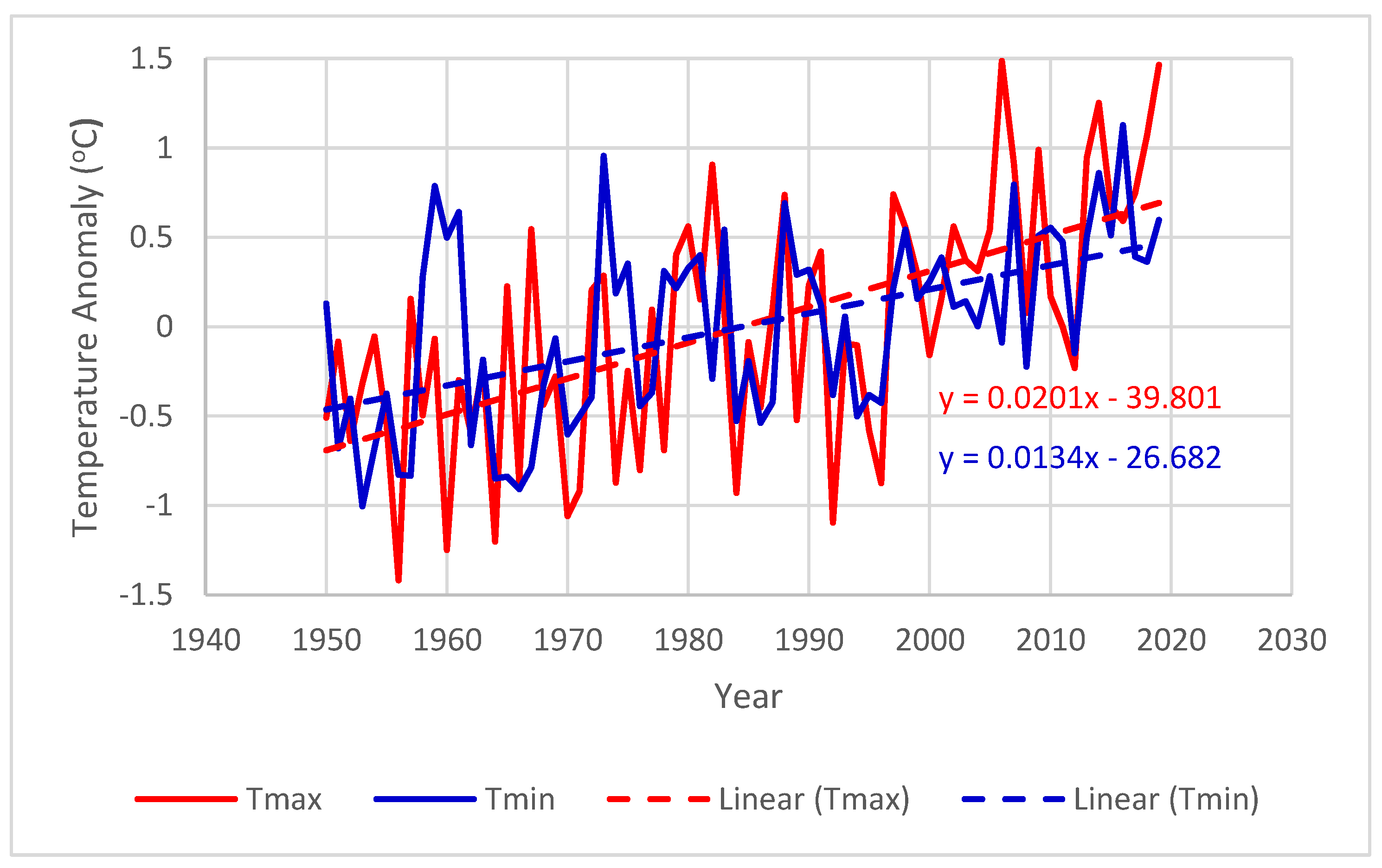

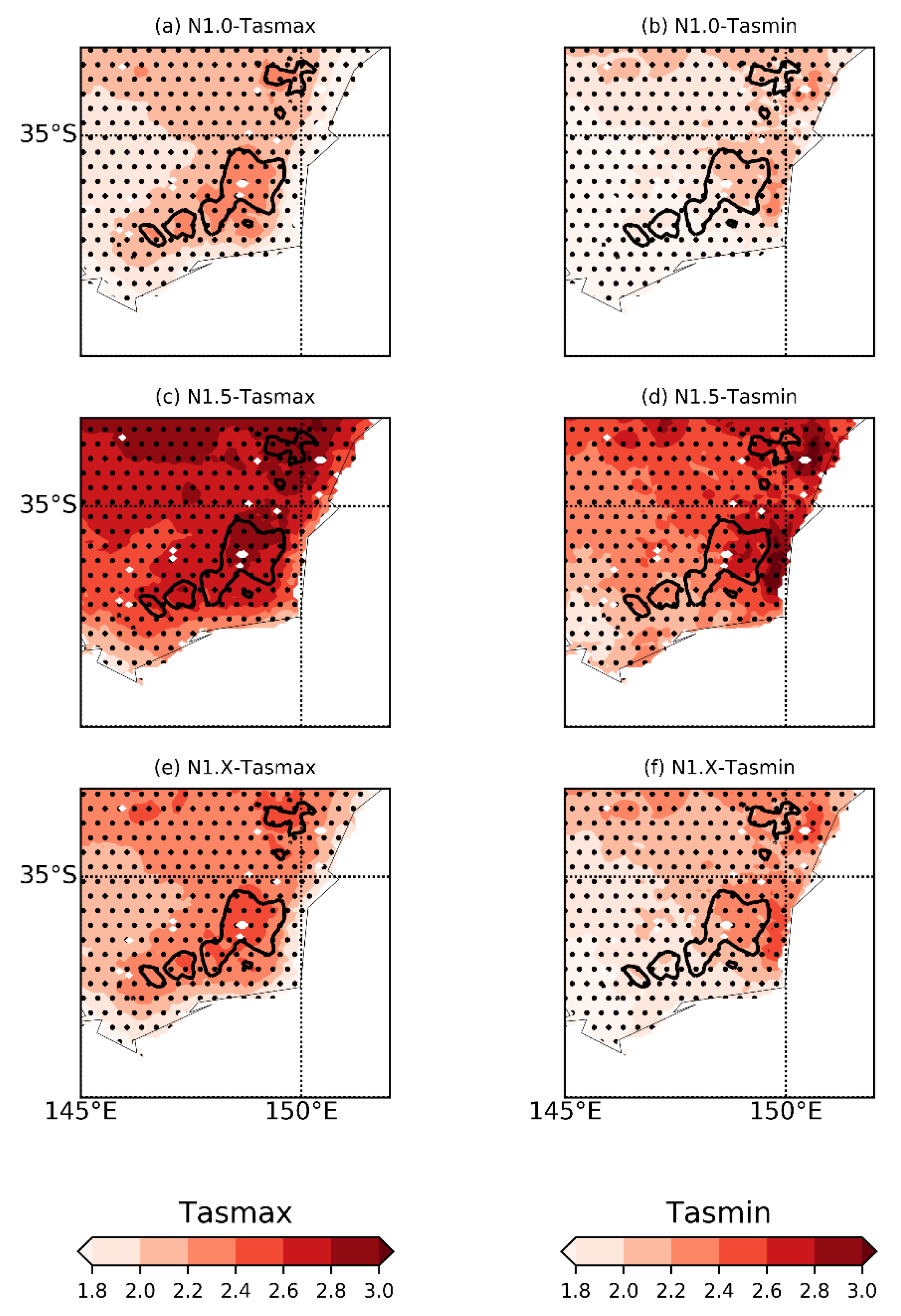

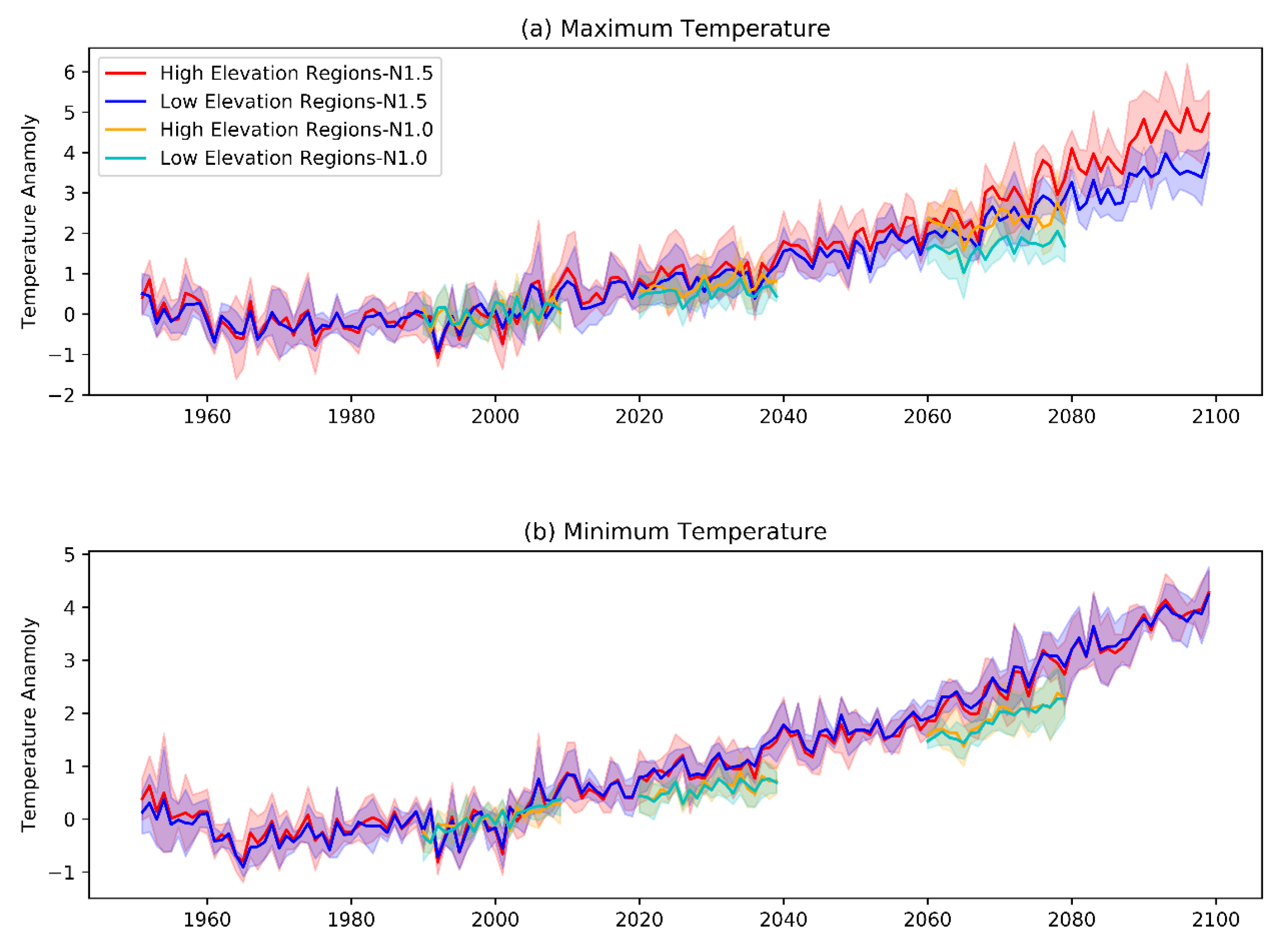
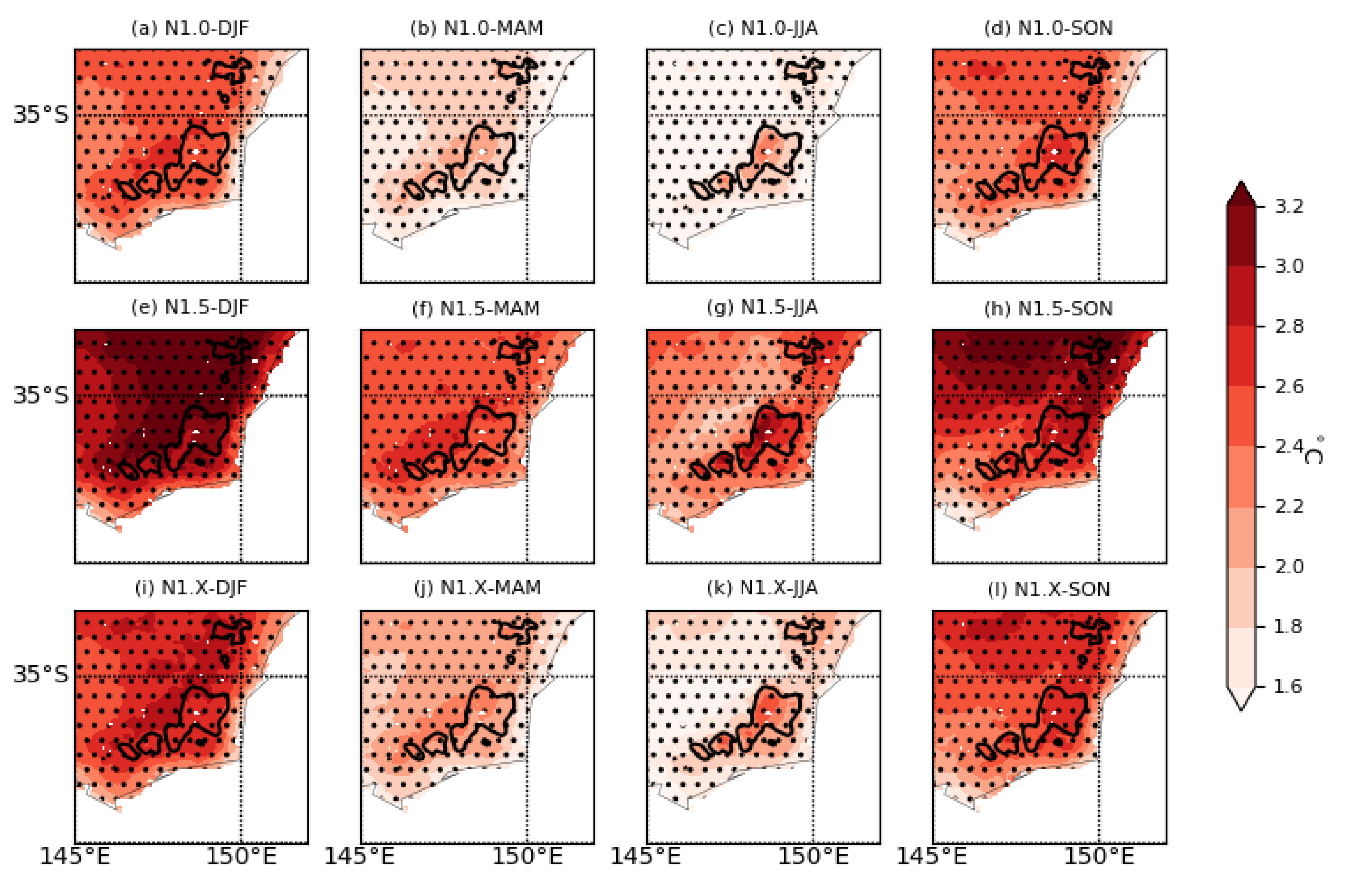
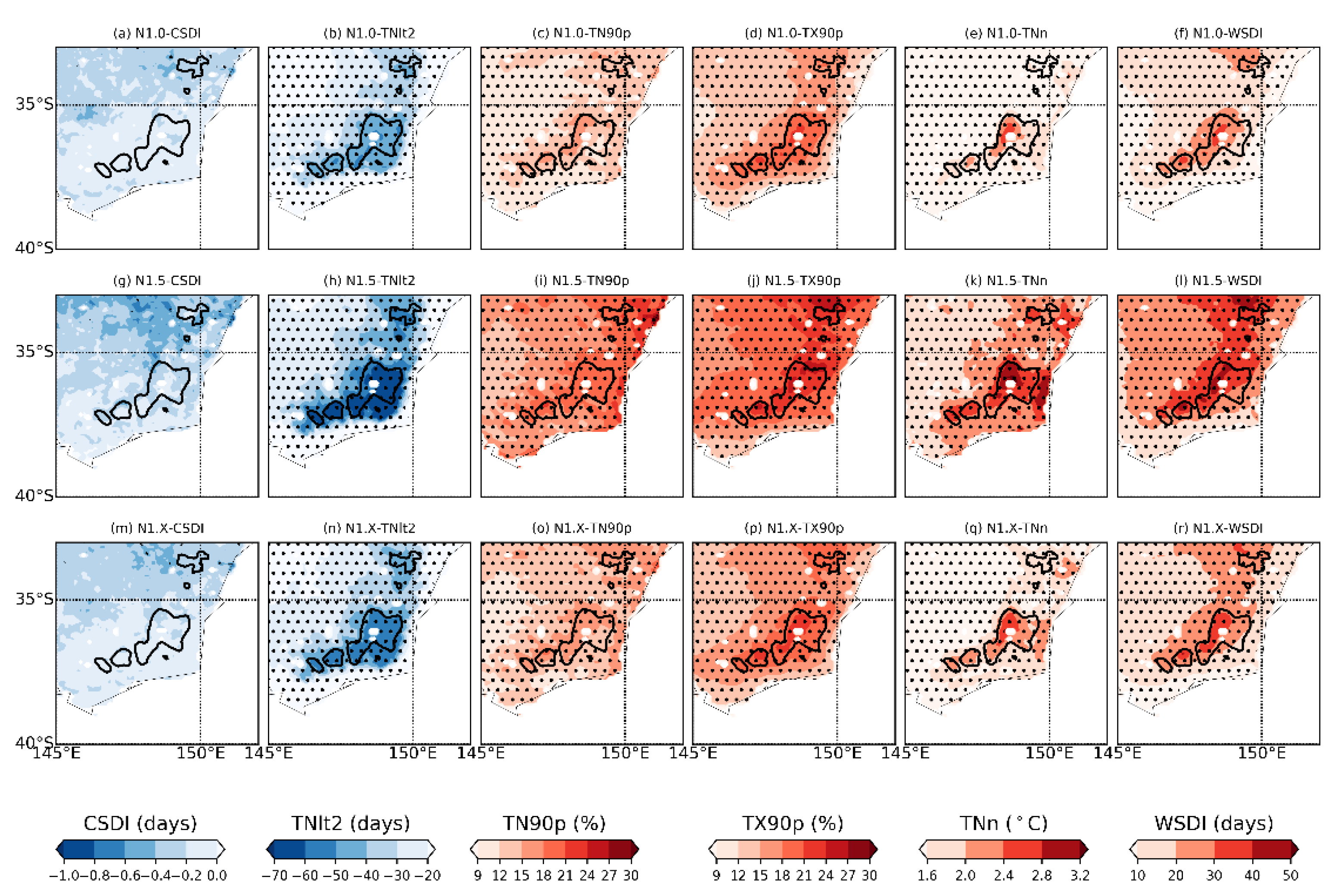

| Simulation-Name | Driving GCM | RCM | WRF Version | Historical Period | Future Periods | CMIP Future Pathway |
|---|---|---|---|---|---|---|
| CGCM3.1-R1 | CGCM3.1 | R1 | WRF3.3 | 1990–2009 | 2020–2039; 2060–2079 | SRES A2 |
| CGCM3.1-R2 | CGCM3.1 | R2 | WRF3.3 | 1990–2009 | 2020–2039; 2060–2079 | SRES A2 |
| CGCM3.1-R3 | CGCM3.1 | R3 | WRF3.3 | 1990–2009 | 2020–2039; 2060–2079 | SRES A2 |
| MK3.0-R1 | Mk3.0 | R1 | WRF3.3 | 1990–2009 | 2020–2039; 2060–2079 | SRES A2 |
| MK3.0-R2 | Mk3.0 | R2 | WRF3.3 | 1990–2009 | 2020–2039; 2060–2079 | SRES A2 |
| MK3.0-R3 | Mk3.0 | R3 | WRF3.3 | 1990–2009 | 2020–2039; 2060–2079 | SRES A2 |
| ECHAM5-R1 | ECHAM5 | R1 | WRF3.3 | 1990–2009 | 2020–2039; 2060–2079 | SRES A2 |
| ECHAM5-R2 | ECHAM5 | R2 | WRF3.3 | 1990–2009 | 2020–2039; 2060–2079 | SRES A2 |
| ECHAM5-R3 | ECHAM5 | R3 | WRF3.3 | 1990–2009 | 2020–2039; 2060–2079 | SRES A2 |
| MIROC-R1 | MIROC | R1 | WRF3.3 | 1990–2009 | 2020–2039; 2060–2079 | SRES A2 |
| MIROC-R2 | MIROC | R2 | WRF3.3 | 1990–2009 | 2020–2039; 2060–2079 | SRES A2 |
| MIROC-R3 | MIROC | R3 | WRF3.3 | 1990–2009 | 2020–2039; 2060–2079 | SRES A2 |
| CanESM2-R1 | CanESM2 | R1 | WRF3.6 | 1951–2005 | 2006–2100 | RCP8.5 |
| CanESM2-R2 | CanESM2 | R2 | WRF3.6 | 1951–2005 | 2006–2100 | RCP8.5 |
| ACCESS1-0-R1 | ACCESS1-0 | R1 | WRF3.6 | 1951–2005 | 2006–2100 | RCP8.5 |
| ACCESS1-0-R2 | ACCESS1-0 | R2 | WRF3.6 | 1951–2005 | 2006–2100 | RCP8.5 |
| ACCESS1-3-R1 | ACCESS1-3 | R1 | WRF3.6 | 1951–2005 | 2006–2100 | RCP8.5 |
| ACCESS1-3-R2 | ACCESS1-3 | R2 | WRF3.6 | 1951–2005 | 2006–2100 | RCP8.5 |
| No | Index | Definition | Units | Timescale | Sectors |
|---|---|---|---|---|---|
| 1. | CSDI | Cold spell duration indicator (Annual count of days with at least 6 or more consecutive days when minimum temperature < 10th percentile) | days | Annual | Health, agriculture and food security, coasts, disaster risk reduction, energy, fisheries, forestry/GHGs, cryosphere |
| 2. | TNlt2 | Number of days when minimum temperature below 2 °C | days | Monthly/Annual | Agriculture and food security, forestry/GHGs, cryosphere |
| 3. | TN90p | Number of warm nights | days | Annual | Energy |
| 4. | TX90p | Number of warm days | days | Annual | Energy |
| 5. | WSDI | Warm spell duration indicator (Annual number of days contributing to events where 6 or more consecutive days experience maximum temperature > 90th percentile) | days | Annual | Health, agriculture and food security, water resources and food security, coasts, disaster risk reduction, energy, fisheries, forestry/GHGs, cryosphere |
| 6. | TNn | Coldest daily minimum temperature | °C | Annual/Monthly | Agriculture and food security, energy, forestry/GHGs, cryosphere |
Publisher’s Note: MDPI stays neutral with regard to jurisdictional claims in published maps and institutional affiliations. |
© 2022 by the authors. Licensee MDPI, Basel, Switzerland. This article is an open access article distributed under the terms and conditions of the Creative Commons Attribution (CC BY) license (https://creativecommons.org/licenses/by/4.0/).
Share and Cite
Ji, F.; Nishant, N.; Evans, J.P.; Di Luca, A.; Di Virgilio, G.; Cheung, K.K.W.; Tam, E.; Beyer, K.; Riley, M.L. Rapid Warming in the Australian Alps from Observation and NARCliM Simulations. Atmosphere 2022, 13, 1686. https://doi.org/10.3390/atmos13101686
Ji F, Nishant N, Evans JP, Di Luca A, Di Virgilio G, Cheung KKW, Tam E, Beyer K, Riley ML. Rapid Warming in the Australian Alps from Observation and NARCliM Simulations. Atmosphere. 2022; 13(10):1686. https://doi.org/10.3390/atmos13101686
Chicago/Turabian StyleJi, Fei, Nidhi Nishant, Jason P. Evans, Alejandro Di Luca, Giovanni Di Virgilio, Kevin K. W. Cheung, Eugene Tam, Kathleen Beyer, and Matthew L. Riley. 2022. "Rapid Warming in the Australian Alps from Observation and NARCliM Simulations" Atmosphere 13, no. 10: 1686. https://doi.org/10.3390/atmos13101686
APA StyleJi, F., Nishant, N., Evans, J. P., Di Luca, A., Di Virgilio, G., Cheung, K. K. W., Tam, E., Beyer, K., & Riley, M. L. (2022). Rapid Warming in the Australian Alps from Observation and NARCliM Simulations. Atmosphere, 13(10), 1686. https://doi.org/10.3390/atmos13101686









